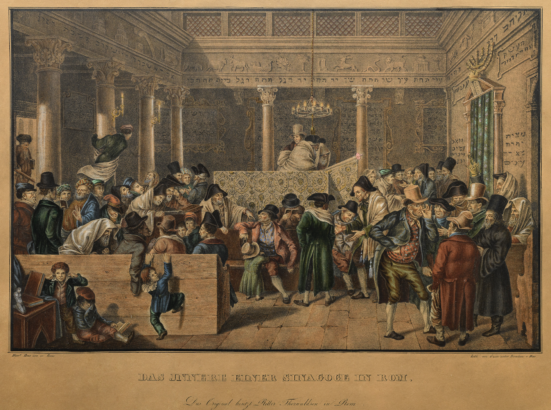A dialogue between parallel histories

Approaching Jewish architecture, especially regarding symbolic places such as synagogues and cemeteries, requires confronting the delicate fabric of identity. From this premise, Andrea Morpurgo, the curator with rabbi Amedeo Spagnoletto of Houses of Life – Synagogues and Cemeteries in Italy, analyzes the evolution of Jewish public spaces in Italy in an essay published in the exhibition’s catalog, which we publish here an excerpt.
By Andrea Morpurgo
A community’s cultural identity is normally either anthropological or collec¬tive: the former is basically personal dimension, the latter evolves with the socio-political events of a given group, with reference to a shared historical memory, whose image often depends on representative monuments and build¬ings (Ascherson 2007). Studying the meaning of identitarian relations that en¬sue between architecture and its place, requires understanding the factors that contributed to the definition of their presence, the transformations and their possible destruction or abandonment.
In other words, how architecture and its linguistic and typological codes have translated the identity of the context, its cultural and ideological orientation: this will tell us a lot about the identity of a community, in time and space (Coppola Pignatelli 1992).
Given these premises, an understanding of Jewish architecture – synagogues and cemeteries – necessarily entails dealing with their identity spaces where forms and styles cannot be merely credited to promoters and designers. Jew¬ish architecture is the result of a complex collective processes triggered to mirror facets of the community’s identity, translated into space, throughout time and places inhabited, and not just to address functional needs.
These spaces are important first and foremost because of the story they have to tell: the history of their needs, of the people who used the places and of the events that took place inside them or close by (Coenen Snyder 2013). They must be analysed as the result of the debates and discussions surrounding their design, the influence of movements and architectural styles in time as well as the economic, demographic, local and national political issues that accompanied their history: parallel histories of Jewish synagogues and cem¬eteries, with multiple ongoing exchanges.
After the 1179 Lateran Council that forbid a Christian burial to anyone who lent money, usury became one of the few professions Jews were allowed. Moneylending was required wherever, for urban growth and so very soon very many small communities sprung up throughout the country. Whenev¬er a Jewish nucleus settled in a new place, immediately an agreed conduct (patto di condotta) had to be drawn up. It was a legal contract between the Jewish lender and the community, and the city government on the other. The contract included all the licences the authority granted the Community that was settling: the right of abode for a few years, the possibility to perform ritual slaughter for meat, to have a synagogue and a cemetery, that were key elements for the Jewish community life (Zaggia 2020).
In the Middle Ages, synagogues progressively became key institutions for Jewish identity, places of worship, but also of socialization, education, and study to the point they were referred to as Scola (School). In Southern Italy where there were very many flourishing Jewish Communities, physical and documental evidence indicate that synagogues were architecturally note¬worthy, such as the one in Palermo and Trani. Following the expulsions of Jews at the end of the 15th century, the former had been dismantled and the latter was changed into a church. Synagogues in Central and Northern Italy were normally in the house of the wealthiest member of the Community, or in a house purchased by a member and made available to the Communi¬ty, neither of which could be told from neighbouring dwellings. Cemeteries were generally registered in Cadastre (Land Registry) in the name of the wealthiest Jewish family, at times in an area used for the same purpose in ancient times, although more often the city allocated a burial field ex novo, so long as it did not create ‘problems’, such as that the funeral processions not being allowed to cross the main roads nor pass in front of a church. In other words, the history of Jewish burials was basically a history of discrimi¬nations: the land the authorities allocated to the ‘burial of the Judeans (Jews) was always extra muros, outside the walls, in uncultivated and non-enclosed fields, which is why they were referred to as meadow, field or garden, using the pejorative for field (campaccio) and garden (ortaccio).
The parallel between the events befalling on Jewish synagogues and ceme¬teries continued for many centuries so much so that in 1752, article VIII of the last chapters of on the Tolerance of the Jewish Nation in Genoa, read: “They will be allowed a synagogue that may stay, or be established where they had it so far, and in the Synagogue everyone will have to hold a licence of the Senate [Serenissimo Senato]” and in the article that followed, on cem¬eteries: “They will be allowed to bury their dead in the field [Campo] outside the Gates [Porte di Carbonara], as they did in the past, but public ceremonies are banned, nor can they sing or carry lights, and all are forbidden to inter¬rupt their ceremonies or molest them, under the most severe penalty of the Senate [Serenissimo Senato]” (Jurisdictionalium Hebreorum n. 1391, Secret Archive, Genoa State Archive, cit. in Urbani 1986). Rome is another telling example of common restrictive laws, where the Edict of Jews promulgated by Pope Pius VI in April 1775 (articles XI, XII and XIII) dealt with the two spaces: inscriptions were forbidden on tombs, and secondly that funeral cer¬emonies and rites had to be celebrated very privately in synagogues and in cemeteries, and thirdly it was forbidden to build new synagogues or even to restore old ones (1775 Edict).
Above, Konstantin Von Guise da Hieronymus Hess, Inside of a Roman Synagogue, Printed in Karlsruhe by J. Velten, post 1830 (Jewish Museum of Rome).
